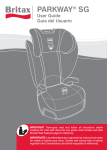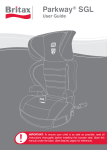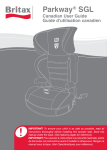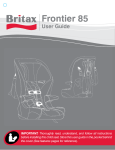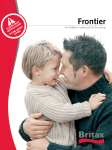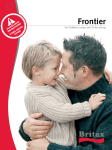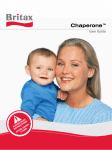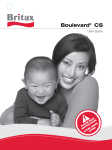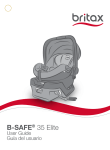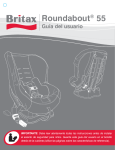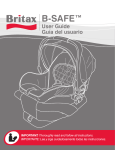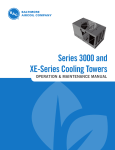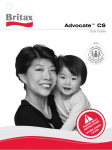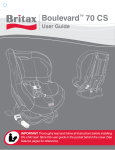Download Guía de usuario
Transcript
Britax Child Safety, Inc. 13501 South Ridge Drive Charlotte, NC 28273 (704) 409.1700 STATUS: APPROVED THIS ARTWORK IS THE PROPERTY OF BRITAX CHILD SAFETY, INC. INFORMATION CONTAINED HERIN IS CONFIDENTIAL AND MAY NOT BE LENT, COPIED, OR OTHERWISE DISCLOSED TO THIRD PARTIES WITHOUT EXPRESS WRITTEN CONSENT. DATE: CREATED BY: 12 JAN 2012 JJMc PART NUMBER: P465900 REVISION LEVEL: 1 TITLE: Parkway SGL - US User Guide ENG/SPN MEDIA: White 60# Opaque Offset (Self Cover) Fonts Used: Swis721 BT family Colors: PMS 186 C, Black Binding: Saddle Stitch DIMENSIONS: 4.75 x 6.625 inches IMPORTANT NOTES: Drill a hole 1/8” in diameter 1/8” from top and bind side as indicated by blue circle guide. Revision Log: R1 - New user guide with Spanish added TOXICITY REQUIREMENTS: All materials used shall not exceed the levels of phthalates and lead content specified in the most recent Consumer Product Safety Improvement Act (CPSIA). The 6 phthalates listed below cannot exceed 0.1% in any individually tested component or item: diisononyl phthalate (DINP) diisodecyl phthalate (DIDP) di-n-octyl phthalate (DnOP) di-(2-ethylhexyl) phthalate (DEHP) dibutyl phthalate (DBP) benzyl butyl phthalate (BBP) DO NOT PRINT THIS PAGE Parkway® SGL User Guide Guía del usuario PARKWAY SGL IMPORTANT: To ensure your child is as safe as possible, read all instructions thoroughly before installing this booster seat. Store this manual under the base. (See features pages for reference). IMPORTANTE: Para garantizar la seguridad del niño, lea detenidamente todas las instrucciones antes de instalar este asiento regulable. Guarde este manual bajo la base (utilice las páginas sobre las características de referencia). Table of Contents Safety Information...................................................................... 2 Warnings...................................................................................... 2 Important Notes........................................................................... 4 Certification ................................................................................. 5 Registration.................................................................................. 5 Child Size: Height and Weight Limitations................................. 6 Vehicle Compatibility................................................................. 8 Vehicle Buckle Position............................................................... 9 Vehicle Seat Belts........................................................................ 10 Incompatible Vehicle Seat Belts................................................. 11 Child Seat Features.................................................................... 12 Using the Child Seat.................................................................. 14 Attaching the Backrest................................................................ 14 Removing the Backrest............................................................... 15 Adjusting the Backrest................................................................ 16 Adjusting Head Restraint Height................................................ 17 Using ISOFLEX™......................................................................... 18 SecureGuard™............................................................................ 20 Using the Retractable Cup Holders........................................... 21 Positioning the Booster Seat Positioning the Booster Seat and Securing Your Child with Backrest and ISOFLEX™.................................. 22 Positioning the Booster Seat and Securing Your Child without Backrest and with ISOFLEX™..................... 25 Positioning and Securing Your Child with Backrest and Lap-shoulder Belt Only................................ 28 Positioning and Securing Your Child without Backrest and Lap-shoulder Belt Only........................... 30 Care and Maintenance............................................................... 32 Warranty...................................................................................... 34 ©2010 Britax Child Safety, Inc. All rights reserved. P465900_R1:09.11 This product and its components are subject to change without notice. WARNING! DEATH or SERIOUS INJURY can occur: • Use only with children who weigh between 40 and 120 lbs (18.1 and 54.4 kg) and whose height is between 38 and 63 inches (96.5 and 160 cm). • Use only the vehicle’s lap and shoulder belt system when restraining the child in this booster seat. • Secure this child restraint with the vehicle child restraint anchorage system if available, or with a vehicle seat belt. • Follow all instructions on this child restraint and in the written instructions located under the base of the seat. • Register your child restraint with the manufacturer. • This booster seat is NOT for use with children who weigh less than 40 lbs (18.1 kg). • Use this booster seat forward-facing only. • DO NOT use this booster seat as a backless booster seat unless it is used in a seating position with a vehicle head restraint. • DO NOT use this booster seat as a backless booster seat unless proper vehicle belt placement can be achieved. • This booster seat must not be used in the home, in boats, or in other non-certified applications. • Secure this booster seat with a vehicle child restraint anchorage system or a vehicle seat belt even when it is not occupied. In a crash, an unsecured booster seat may injure other occupants. 2 • Based on crash statistics, the National Highway Traffic Safety Administration (NHTSA) recommends that parents select the rear seat as the safest location for a properly positioned booster seat. Please study the section on Vehicle Compatibility in this booklet to ensure the child’s safety. If in doubt about installing this booster seat, consult the vehicle owner’s manual. • DO NOT use any part of this booster seat with other seat cushions or backrests. • The use of non-Britax covers, inserts, toys, accessories or tightening devices is not approved by Britax. Their use could cause this booster seat not to perform as intended. • To prevent injury due to deterioration, discontinue use of a booster seat that is older than six years or has been in a severe crash. • The primary protection for occupants of a vehicle in a collision is the structure of the vehicle itself; a booster seat will not protect a child when the vehicle is seriously impacted. However, correctly installed, a booster seat will substantially improve the chances for survival in most crashes. Make sure that all users fully understand the correct ways to use this booster seat in a vehicle. 3 Safety Information Safety Information Important Notes Certification • The NHTSA and the American Academy of Pediatrics recommends that children should remain in a child seat with a 5-point harness until reaching the maximum weight or height allowed. • Cover the booster seat when the vehicle is parked in direct sunlight. Parts of the booster seat could become hot enough to burn a child. • Store the booster seat in a safe place when it is not being used. Avoid placing heavy objects on top of the booster seat. • DO NOT leave children alone in a vehicle, even for a short time. • DO NOT, except as described in this booklet, attempt to disassemble any part of the booster seat or change the way the vehicle’s seat belts are used. • DO NOT leave loose objects, e.g. books, bags, etc., in the back of a vehicle. In the event of a sudden stop, loose objects will keep moving, potentially causing serious injuries. • DO NOT leave folding vehicle seats unsecured. In the event of a sudden stop, a loose seat back could cause the booster seat not to perform as intended. • DO NOT allow children to play with this booster seat. • DO NOT use anything to raise the booster seat off the vehicle seat. In a crash, this could cause the booster seat not to perform as intended. This child restraint system conforms to all applicable Federal Motor Vehicle Safety Standards (FMVSS 213). This Child Restraint is Approved for Use in Motor Vehicles. This Restraint is Not Certified for Use in Aircraft, because Aircraft do not have shoulder belts. 4 Registration Child restraints could be recalled for safety reasons. You must register this restraint to be reached in a recall. Send your name, address, e-mail address if available, and the restraint’s model number and manufacturing date to Britax Child Safety, Inc. P.O. Box 91167 Allentown, PA 18109-9925, or call 1-888-427-4829, or register online at www.BritaxUSA. com/registration. For recall information, call the U.S. Government’s Vehicle Safety Hotline at 1-888-327-4236 (TTY 1-800-424-9153), or go to http://www.NHTSA.gov. For your convenience, record all the information about your booster seat below. Refer to the Serial Number and Manufacture Date Label for all information, see page 13. Model Name and Number:________________________________ Serial Number:__________________________________________ Batch Number:__________________________________________ Date of Manufacture:_____________________________________ 5 Safety Information Child Size: Height and Weight Limitations When Using with Backrest Only use forward-facing with children: • who weigh between 40 and 120 lbs (18.1 and 54.4 kg) and • who are between 38 and 63 in. (96.5 and 160 cm) in height and • when the top of the child’s ears are below the top of the head restraint (Fig. A) and • when the shoulder belt lies across the center of the child’s chest and is positioned at or above the child’s shoulder through the shoulder belt guide and A • when the lap belt is routed under the armrests, through the SecureGuard, across the child’s upper thighs. 6 Safety Information When Using without Backrest Only use forward-facing with children: • who weigh between 40 and 120 lbs (18.1 and 54.4 kg) and • who are between 38 and 63 in. (96.5 and 160 cm) in height and • when the top of the child’s ears are below the top of the vehicle head restraint and • when the shoulder belt lies across the center of the child’s chest and is positioned at or above the child’s shoulder (Fig. C) and • when the lap belt is routed under the armrests, through C the SecureGuard, across the child’s upper thighs. 7 Vehicle Compatibility WARNING! Based on crash statistics, the National Highway Traffic Safety Administration (NHTSA) recommends that parents select the back seat as the safest location for a properly positioned booster seat. DO NOT place a booster seat on the front seat with an air bag unless it is deactivated. DEATH or SERIOUS INJURY can occur. See your vehicle owner’s manual for booster seat positioning instructions. The back seat is the safest place for children 12 and under. This booster seat must only be used in forward-facing vehicle seats. Side-facing or rear-facing seats CANNOT be used. For questions about positioning the booster seat consult the vehicle owner’s manual. Some vehicles have no seating positions which are compatible with this booster seat or any other child seat. See diagram below. 8 Vehicle Compatibility Vehicle Buckle Position WARNING! The position of the vehicle seat belt buckle can adversely affect the stability of the booster seat. If the buckle lies near the incorrect position ( ) when the vehicle seat belt is tightened, try fitting the booster seat in another seating position OR consult your vehicle owner’s manual to see if you can lower the vehicle buckle position by twisting the vehicle buckle stalk. If it is not possible to achieve the correct position ( ) for the buckle, then another seating position or child seat MUST be used. 9 Vehicle Compatibility Vehicle Seat Belts IMPORTANT: Vehicle seats and vehicle seat belts differ from vehicle to vehicle. Refer to your vehicle owner’s manual for specific information about vehicle seat belts and their use with child seats. This booster seat can fit securely in most vehicles using existing vehicle seat belts. However, some vehicles do not have seating positions which are compatible with this booster seat or any other child seat. If in doubt, contact the vehicle manufacturer for assistance. To protect your child in a crash, you must use this booster seat with vehicle seat belts that are compatible. This booster seat can only be used with three-point (shoulder and lap) vehicle seat belts. The vehicle owner’s manual will have information on the types of vehicle seat belts in your vehicle. If your vehicle seat belt type is identified on page 11 as incompatible, select another seating position. 10 Vehicle Compatibility Incompatible Vehicle Seat Belts WARNING! The following types of vehicle seat belts are NOT compatible with this booster seat: 1 Vehicle seat belts with top or bottom anchor points on the vehicle door. 2 4 Lap-shoulder belts that have a separate retractor each for the lap and shoulder parts. Inflatable lapshoulder belts. 5 3 Motorized, automatic vehicle seat belts Lap belts of any kind. 11 Child Seat Features Child Seat Features 1 2 PARKWAY 21 SGL PARKWAY SG L Parkway® SGL User Guide 3 13 IMPORTANT: To ensure your child is as safe as possible, read all instructions thoroughly before installing this child seat. Store this manual under the base. (See features pages for reference). 4 12 22 5 6 7 13 18 9 10 8 20 11 14 19 16 15 = 17 23 1 Head Restraint 10 ISOFLEX™ Adjuster Strap 18 Backrest Hinge Cylinder 2 Head Restraint Cover 11 Cup/Snack Holders 19 Base Hinge Slot 3 Backrest Cover 12 Head Restraint Height Adjuster 20 SecureGuard™ Adjuster 4 Backrest 13 Shoulder Belt Guides 21 User Guide Storage Slot 5 Armrests 14 Lower Connector Release Button 6 SecureGuard™ Clip 15 Lower Connectors 22 Serial Number and Manufactured Date Label 7 Base Belt Guide 16 Base 8 Base Cover 17 Elastic Retainers 9 ISOFLEX™ Release Button 12 * Appearance of actual product may vary from images in this user guide. 23 ISOFLEX™ Flexible Lower LATCH Connection System * Appearance of actual product may vary from images in this user guide. 13 Using the Child Seat Using the Child Seat Before you use this booster seat for the first time, you will have to complete the assembly steps below. Removing the Backrest Attaching the Backrest 2 Detach the seat cover from the base by unhooking the elastic loops from the elastic retainers on the back of the base (Fig. E). IMPORTANT: Keep fingers away from moving parts to avoid potential injury. 1 Detach the elastic loops from the elastic retainers on the base cover from the back of the booster seat base (Fig. A). 2 Place the base on a flat surface. From the child’s left side of the booster seat, align the backrest hinge cylinder with the hinge slot on the base. 3 Push the backrest hinge all the way into the base hinge slot (Fig. B). IMPORTANT: DO NOT rotate the backrest until the cylinder has been completely inserted into the base hinge slot. Rotating the backrest before it has been completely inserted may result in damage to the booster seat. A 1 Place the booster seat on a flat surface. 3 Push the backrest down until it lies flat and align the backrest hinge cylinder with the hinge slot on the base (Fig. F). E 4 Slide the backrest from the child’s left side of the base (Fig. G). B 5 Attach the elastic loops of the base cover to the elastic retainers on the back of the base (Fig. H). F NOTE: Store the backrest in a safe place. C G D H 4 Rotate the backrest up until it doesn’t rotate into the flat position under its own weight (Fig. C). 5 Attach the elastic loops of the base cover to the elastic retainers on the back of the booster seat (Fig. D). 14 15 Using the Child Seat Using the Child Seat Adjusting the Backrest WARNING! Reclining the vehicle seat back may adversely affect the position of the vehicle seat belt across the child and may result in death or serious injury in a crash. Refer to your vehicle owner’s manual for information on adjusting the vehicle seat back with child seats. Adjusting Head Restraint Height The head restraint can be adjusted and locked into different positions. Choose the position best suited to your child’s safety. See page 6. Tip: Check the fit with child seated in booster seat. Ensure that the shoulder belt guides are even with, or just above, the child’s shoulder. See page 6. 1 Squeeze and hold the height adjustment handle to adjust the head restraint (Fig. A). Push the backrest until it rests against the vehicle seat back (Fig. A). If the vehicle seat back is adjustable, move it to the upright position. 2 Slide head restraint up or down to the desired level (Fig. B). A 3 Release the adjustment handle. Repeat this process until the shoulder belt rests comfortably across the center of the child’s chest when positioned through the shoulder belt guide (Fig. C). A 4 Ensure the head restraint has locked into place. IMPORTANT: Do not recline the backrest past the allowable adjustable range (Fig. B). B B C 16 17 Using the Child Seat Using the Child Seat Using ISOFLEX™ Flexible Lower LATCH Connection System The ISOFLEX™ System helps to anchor the booster seat into the car for added stability and safety in the event of a crash. LOWER UNIVERSAL ANCHORAGE SYSTEM LOCATIONS Using the Lower Connectors Where to find the Lower Connectors The lower connectors are located in the back of the base of the booster seat. Store the connectors in the slots when not in use. To remove the lower connector from the storage slot or lower anchor: 1 Press and hold the red release button. 2 Pull the lower connector from the storage slot or lower anchor. Lower Lower Anchors The figure above shows typical locations for lower anchors in a vehicle. Check your vehicle owner’s manual to learn if it is equipped with lower anchors. Standard vehicle seat spacing between lower anchors is 11 inches (27.9 cm). This child seat can be used in a seating position with up to 20 inches (50.8 cm) of space between the lower anchors if the vehicle manufacturer allows. 18 To attach the lower connector to the storage slot or lower anchor: Top Firmly push the lower connector into the slot or lower anchor until a click is heard. 19 Using the Child Seat Using the Child Seat 2 Pull the SecureGuard™ adjuster away from the base. SecureGuard™ Britax recommends using SecureGuard to achieve the best vehicle seat belt placement. The SecureGuard™ clip should hold the lap part of the vehicle seat belt in place. The SecureGuard™ clip should be adjusted to keep the lap part of the vehicle seat belt positioned low across your child’s upper thighs (Fig. A). Ensure the bottom edge of the SecureGuard™ clip is level with your child’s upper thighs, however, the clip itself should not press into your child’s upper thighs. 3 Feed the end of the SecureGuard™ webbing through the SecureGuard™ adjuster (Fig. D). A D 5 Move the SecureGuard™ clip to the center of the SecureGuard™ webbing. IMPORTANT: The lap part of the vehicle seat belt must not rest on the child’s abdomen. Adjusting SecureGuard™ Fit • To Shorten: 4 Pull the webbing to remove slack from the SecureGuard™ adjuster. B The lower edge of the SecureGuard™ clip should be level with the child’s upper thighs once they have been secured in the booster seat. Using the Retractable Cup Holders 1 Locate the SecureGuard™ adjuster under the base. See page 13. 2 Pull the SecureGuard™ adjuster away from the base. C 3 Feed the webbing through the SecureGuard™ adjuster (Fig. B). 4 Pull the end of the SecureGuard™ adjuster webbing to tighten (Fig. C). • To Lengthen: 1 Locate the SecureGuard™ adjuster under the base. See page 13. 20 Pull the cup holder out from the booster base to use. Push the cup holder into the booster base to store. IMPORTANT: • DO NOT use with hot liquids. • DO NOT step on or put excess weight on the cup holder. 21 Positioning the Booster Seat Positioning the Booster Seat Positioning the Booster Seat and Securing Your Child with Backrest and ISOFLEX™ 4 BEFORE YOU BEGIN: 99Check that your vehicle has lower anchors. 99If the vehicle seat back is adjustable, ensure it is in the upright position before placing the booster seat on the vehicle seat. 99Adjust the head restraint appropriately to fit child (see page 17). 1 Remove lower connectors from the storage slots in the base (Fig. A). 2 Push the ISOFLEX™ adjuster release button on one side of the booster seat and pull to fully extend the lower connector strap. Then repeat on the opposite side to ensure that all slack has been released from the ISOFLEX™ system (Fig. B). 3 Place the booster on the vehicle seat. * Using the lower anchor farthest from you first will allow for easiest positioning. * You may need to turn the back of the booster seat towards you for easier access to the lower anchors. NOTE: If a click is not heard when connecting the lower connectors, the lower connector strap may be twisted or there may be debris in the lower connector. Correct either situation before continuing with the positioning process. 5 NOTE: Before using the booster seat for the first time, you will need to complete the assembly instructions on page 14. A Verify that the ISOFLEX™ straps are not twisted and push the lower connectors onto their adjacent lower anchors (Fig. C). * A click confirms attachment. Ensure that the booster seat is positioned correctly on the vehicle seat (Fig. D). Guide the seat into place while pulling the ISOFLEX™ adjuster strap on either side of the booster seat to remove slack (Fig. E). NOTE: * If needed, adjust or remove the vehicle’s head restraint to allow the backrest to lie flat against the vehicle’s seat back. * Only tighten until the slack is removed from the strap. Overtightening the strap can force the backrest of the booster seat forward (Fig. F). C D E B F 22 23 Positioning the Booster Seat 6 Sit your child in the booster seat and check the head restraint for proper height adjustment. 7 Pull the vehicle seat belt out and route the shoulder part of the vehicle seat belt through the upper belt guide (Fig. F). 8 Route the lap part of the vehicle seat belt under the armrest and over both red belt guides (Fig. G). 9 Positioning the Booster Seat Positioning the Booster Seat and Securing Your Child without Backrest and with ISOFLEX™ BEFORE YOU BEGIN: 99Check that your vehicle has lower anchors. F 99If the vehicle seat back is adjustable, ensure it is in the upright position before placing the booster seat on the vehicle seat. Verify that the vehicle seat belt is not twisted and fasten across the child (Fig. H). 99Ensure the booster seat is positioned in a location that has a vehicle head restraint. 10 Route the lap part of the vehicle seat belt through the SecureGuard™ clip (Fig. I). * The lap part of the vehicle seat belt should rest low on the child’s upper thighs. G 11 Remove slack from the vehicle seat belt. * The shoulder part should cross the chest in the center of the child’s collar bone. Checklist 99Vehicle seat belt is not twisted 99Vehicle seat belt is securely fastened 99Shoulder part of the vehicle seat belt is routed through the shoulder belt guide 99Lap part of the vehicle belt is routed through the SecureGuard™ clip 99Vehicle seat belt is properly positioned low across the child’s upper thighs and does not contact the child’s neck 99If the lower connectors in your vehicle prevent proper vehicle belt fit across your child you cannot use the lower anchors to position this booster seat 24 1 Remove lower connectors from the storage slots in the base (Fig. A). 2 Push the ISOFLEX™ adjuster release button on one side of the booster seat and pull to fully extend the lower connector strap. Then repeat on the opposite side to ensure that all slack has been released from the ISOFLEX™ system (Fig. B). H 3 I 4 Place the booster seat on the vehicle seat. * Using the lower anchor farthest from you first will allow for easiest positioning. * You may need to turn the back of the booster seat toward you for easier access to the lower anchors. Verify that the ISOFLEX™ straps are not twisted and push the lower connectors onto their adjacent lower anchors (Fig. C). * A click confirms attachment. A B C 25 Positioning the Booster Seat Positioning the Booster Seat NOTE: If a click is not heard when connecting the lower connectors, the lower connector strap may be twisted or there may be debris in the lower connector. Correct either situation before continuing with the positioning process. 5 Ensure that the booster seat is positioned correctly on the vehicle seat (Fig. D). Guide the seat into place while pulling the ISOFLEX™ adjuster strap on either side of the booster to remove slack (Fig. E). 10 Route the lap part of the vehicle seat belt through the SecureGuard™ clip (Fig. G). * The lap part of the vehicle seat belt should rest low on the child’s upper thighs. G D 11 Remove slack from the vehicle seat belt. * The shoulder part should cross the chest in the center of the child’s collar bone (Fig. H). NOTE: Only tighten until the slack is removed from the strap. H E 6 Sit your child in the booster seat. 7 Pull the vehicle seat belt out, positioning the lap belt under both armrests and over both red belt guides (Fig. F). 8 Verify that the vehicle seat belt is not twisted and then fasten. 9 Adjust the vehicle seat belt’s shoulder part so that it crosses the chest and center of the child’s collar bone. 26 Checklist F 99Vehicle seat belt is not twisted 99Vehicle seat belt is securely fastened 99Lap part of the vehicle belt is routed through the SecureGuard™ clip 99Vehicle seat belt is properly positioned low across the child’s upper thighs and does not contact the child’s neck 99If the lower connectors in your vehicle prevent proper vehicle belt fit across your child you cannot use the lower anchors to position this booster seat 27 Positioning the Booster Seat Positioning the Booster Seat Positioning and Securing Your Child with Backrest and Lap-shoulder Belt Only BEFORE YOU BEGIN: 99If the vehicle seat back is adjustable, ensure it is in the upright position before placing the booster seat on the vehicle seat. 4 Pull the vehicle seat belt out and route the shoulder part of the vehicle seat belt through the upper belt guide (Fig. C). 5 Route the lap part of the vehicle seat belt under both armrests, over your child’s upper thighs and over both red belt guides (Fig. D). 6 Verify that the vehicle seat belt is not twisted and then fasten the vehicle seat belt across the child (Fig. E). 7 Route the lap part of the vehicle seat belt through the SecureGuard™ clip (Fig. I). * The lap part of the vehicle seat belt should rest low on the child’s upper thighs. 99Adjust the head restraint appropriately to fit child (see page 17). Note: Before using the booster seat for the first time, you will need to complete the assembly instructions on page 14. 1 Place the booster seat on the vehicle seat. 2 Push the backrest until it rests against the vehicle seat back (Fig. A). If the vehicle seat back is adjustable, move it to the normal upright position. 8 A 28 Sit your child in the booster seat and check the head restraint for proper height adjustment (Fig. B). D Remove slack from the vehicle seat belt. * The shoulder part should cross the chest in the center of the child’s collar bone. E NOTE: If needed, adjust or remove the vehicle’s head restraint to allow the backrest to lie flat against the vehicle’s seat back. 3 C B Checklist 99Vehicle seat belt is not twisted 99Vehicle seat belt is securely fastened 99Shoulder part of the vehicle seat belt is routed through the shoulder belt guide 99Lap part of the vehicle belt is routed through the SecureGuard™ clip 99Vehicle seat belt is properly positioned low across the child’s upper thighs and does not contact the child’s neck F 29 Positioning the Booster Seat Positioning the Booster Seat Positioning and Securing Your Child without Backrest and Lap-shoulder Belt Only BEFORE YOU BEGIN: 99If the vehicle seat back is adjustable, ensure it is in the upright position before placing the booster seat on the vehicle seat. 99Ensure the booster seat is positioned in a location that has a vehicle head restraint. Note: Before using the booster seat without the backrest, you may need to complete the removal instructions on page 15. 9 14 Route the lap part of the vehicle seat belt through the SecureGuard™ clip (Fig. C). * The lap part of the vehicle seat belt should rest low on the child’s upper thighs. 15 Remove slack from the vehicle seat belt. * The shoulder part should cross the chest in the center of the child’s collar bone. C Checklist 99Vehicle seat belt is not twisted 99Vehicle seat belt is securely fastened 99Lap part of the vehicle belt is routed through the SecureGuard™ clip 99Vehicle seat belt is properly positioned low across the child’s upper thighs and does not contact the child’s neck Place the booster seat base on the vehicle seat and push it back against the vehicle seat back. 10 Sit your child in the booster seat. 11 Pull the vehicle seat belt out from the retractor, positioning the lap belt under both armrests and over both red belt guides (Fig. A). A 12 Verify that the vehicle seat belt is not twisted and then fasten across the child. 13 Adjust the vehicle seat belt’s shoulder part so that it crosses the chest and center of the child’s collar bone (Fig. B). B 30 31 Care and Maintenance Care and Maintenance Cover Removal Cleaning the Cover Removing the Backrest Cover • HAND WASH, using cold water and mild soap. • LINE DRY, to prevent cover from shrinking. • DO NOT: Bleach, machine wash, or machine dry. 1 Detach the elastic loops (6 total) from the backrest (Fig. A). 2 Remove the backrest cover. NOTE: Be careful not to damage the EPS foam. A C Replacing the Cover To replace the cover, reverse the steps of each section. Removing the Head Restraint Cover Cleaning the Shell 1 Detach the elastic loops (6 total) from the backrest (Fig. B). 2 Remove the head restraint cover. Removing the Seat Cover 1 Detach the elastic loops (4 total) from the booster seat base (Fig. C). 2 Slide the plastic retainer flaps (3 total) from the front and sides of the booster seat base (Fig. D). B D • SPONGE CLEAN, using warm water and mild soap. • TOWEL DRY • DO NOT: Use solvents, abrasive cleaners, or disassemble the booster seat in any way, except as instructed. 3 Remove the booster seat cover. 32 33 Warranty This booster seat was manufactured by Britax. Britax Child Safety, Inc. (“Britax”) warrants this product to the original retail purchaser as follows: LIMITED WARRANTY This booster seat is warranted against defective materials or workmanship for one year from the date of original purchase. Proof of purchase is required. The exclusive remedy for this warranty is that Britax will, at its option, provide repair or replacement components for this product. Britax reserves the right to discontinue or change fabrics, parts, models or products, or to make substitutions. To make a claim under this warranty, contact Britax Consumer Services at 1-888-427-4829 or write to us using the address on the back cover of this booklet. Proof of purchase is required. PLEASE COMPLETE AND MAIL THE OWNER REGISTRATION CARD WITHIN (30) DAYS OF PURCHASE OR VISIT WWW.BRITAXUSA.COM/REGISTRATION. WARRANTY LIMITATIONS This warranty does not include damages that arise from negligence, misuse or use not in accordance with the product instruction. The use of non-Britax Child Safety, Inc. covers, inserts, toys, accessories, or tightening devices is not approved by Britax. Their use could cause this child seat to fail Federal Safety Standards or not perform as intended in a crash. Their use automatically voids the Britax warranty. LIMITATION OF DAMAGES The warranty and remedies as set forth above are exclusive and in lieu of all others, oral or written, express or implied. In no event will Britax, or the retailer selling this product, be liable for any damages, including incidental or consequential damages, or loss of use arising out of the use or inability to use this product. LIMITATIONS OF WARRANTIES AND OTHER WARRANTY TERMS AND STATE LAWS Any implied warranties, including implied warranties of merchantability and fitness for a particular purpose, shall be limited to the duration and terms of the express written warranty. Some states do not allow limitations on how long an implied warranty lasts or the exclusion or limitation of incidental or consequential damages, so the above limitations may not apply. This warranty gives you specific legal rights, and you may have other rights, which vary from state to state. Neither Britax, nor the retailer selling this product, authorizes any person to create for it any other warranty, obligation, or liability in connection with this product. 34 Índice Información de seguridad...............................................................38 Advertencias...................................................................................... 38 Notas importantes............................................................................. 40 Certificación ...................................................................................... 41 Registro.............................................................................................. 41 Tamaño del niño: Limitaciones de altura y de peso....................... 42 Compatibilidad con el vehículo......................................................44 Posición de la hebilla del vehículo................................................... 45 Cinturones de seguridad de vehículo.............................................. 46 Cinturones de seguridad de vehículo incompatibles..................... 47 Características del asiento de seguridad para niños...................48 Uso del asiento de seguridad para niños......................................50 Instalación del respaldo.................................................................... 50 Extracción del respaldo.................................................................... 51 Ajuste del respaldo........................................................................... 52 Cómo ajustar la altura del reposacabezas...................................... 53 Uso del sistema ISOFLEX™............................................................. 54 SecureGuard™.................................................................................. 56 Uso de los soportes extraíbles para vasos...................................... 57 Colocación del asiento regulable Colocación del asiento regulable y sujeción del niño en asientos con respaldo y sistema ISOFLEX™............................. 58 Colocación del asiento regulable y sujeción del niño en asientos con sistema ISOFLEX™ pero sin respaldo................. 59 Colocación y sujeción del niño en asientos con respaldo y cinturones de banda horizontal y transversal....... 64 Colocación y sujeción del niño en asientos sin respaldo y cinturones de banda horizontal y transversal......... 66 Cuidado y mantenimiento...............................................................68 Garantía.............................................................................................70 ©2011 Britax Child Safety, Inc. Reservados todos los derechos. P465900_R1:03.11 Este producto y sus componentes están sujetos a cambios sin previo aviso. 37 ADVERTENCIA Esto podría causar DAÑOS GRAVES o incluso el FALLECIMIENTO del niño. • Únicamente se debe utilizar con niños que pesan entre 18,1 y 54,4 kg (entre 40 y 120 lb) y miden entre 96,5 y 160 cm (38 y 63 pulgadas). • Cuando se esté utilizando este asiento regulable para sujetar al niño, solo debe usarse el sistema de cinturón de seguridad de banda horizontal y transversal del vehículo. • Asegure este dispositivo de retención infantil con el sistema de anclaje de retención para niños del vehículo (si hay uno disponible) o con el cinturón de seguridad del automóvil. • Siga todas las instrucciones de este dispositivo de retención infantil, así como las instrucciones que se encuentran bajo la base del asiento. • Registre este dispositivo de retención infantil con el fabricante. • Este asiento reclinable no debe utilizarse con niños de peso inferior a 18,1 kg (40 lb). • Utilice este asiento regulable solo orientado hacia delante. • NO utilice este asiento regulable sin respaldo salvo que se utilice en un asiento del vehículo que disponga de reposacabezas. • NO utilice este asiento regulable sin respaldo salvo que se pueda colocar el cinturón de seguridad del vehículo debidamente. • Este asiento regulable no debe utilizarse en casas ni embarcaciones, ni darle cualquier otro uso para el que no esté certificado. • Sujete este asiento regulable con un sistema de anclaje de retención para niños del vehículo o con uno de los cinturones de seguridad del automóvil, aun cuando no esté ocupado, ya que de no estar asegurado podría, en caso de accidente, lastimar a otros ocupantes del vehículo. 38 • Según las estadísticas de accidentes, la Administración Nacional de Seguridad de Tráfico en Carreteras (NHTSA, National Highway Traffic Safety Administration) recomienda que los padres elijan el asiento trasero como el lugar más seguro para colocar adecuadamente un asiento regulable. A fin de garantizar la seguridad del niño, lea detenidamente la sección Compatibilidad con el vehículo incluida en este manual. Si tiene dudas acerca de cómo instalar el asiento regulable, consulte el manual del vehículo. • NO utilice ninguna pieza de este asiento regulable con respaldos o cojines de otros asientos. • Britax no aprueba el uso de cubiertas, piezas, juguetes, accesorios o dispositivos de ajuste que no sean de Britax. El uso de estos podría hacer que el asiento regulable no rinda como debiera. • Para evitar lesiones debido a deterioro, este asiento regulable debe dejar de utilizarse tras seis años de antigüedad o si ha estado implicado en un accidente grave. • En cualquier colisión, la principal protección para los ocupantes es la propia estructura del vehículo; un asiento regulable no protegerá al niño si el vehículo sufre un impacto muy fuerte. Sin embargo, si está instalado correctamente, el asiento regulable aumentará considerablemente las posibilidades de supervivencia en la mayoría de los accidentes. Asegúrese de que todos los usuarios comprenden bien cómo usar este asiento regulable en un vehículo. 39 Información de seguridad Información de seguridad Notas importantes Certificación • La Administración Nacional de Seguridad de Tráfico en Carreteras (NHTSA) y la Academia Americana de Pediatría recomiendan dejar a los niños en un asiento de seguridad infantil con arnés de cinco puntos hasta que alcancen el peso o la altura máximos permitidos. El sistema de retención infantil cumple con todas las normas federales de seguridad automotriz (FMVSS 213). Este sistema de retención infantil está aprobado para su uso en vehículos de motor. Este sistema de retención no está certificado para su uso en aviones, ya que los asientos de estos no vienen equipados con cinturones de seguridad transversales. • Cubra el asiento regulable si deja el vehículo expuesto al sol, ya que las piezas pueden calentarse y quemar al niño. Registro • Guarde el asiento regulable en un lugar seguro cuando no lo esté utilizando. No coloque objetos pesados encima del asiento regulable. • NO deje niños desatendidos en el vehículo, ni siquiera durante un corto periodo de tiempo. • NO intente desmontar ninguna pieza del asiento regulable, a menos que lo haga según se indica en este manual. Utilice los cinturones de seguridad del vehículo únicamente como se indica. • NO deje objetos sueltos, como libros, maletas, etc., en la parte posterior del vehículo, ya que en caso de frenado brusco, los objetos sueltos podrán desplazarse y causar lesiones graves. • NO deje asientos plegables sin asegurar adecuadamente, ya que en caso de frenado brusco, un respaldo suelto podría hacer que el asiento regulable no rinda como debiera. • NO deje que los niños jueguen con el asiento regulable. • NO utilice ningún elemento para elevar el asiento regulable, ya que en caso de accidente, esto podría hacer que el asiento regulable no rinda como debiera. Es posible que algunos dispositivos de retención para niños pudieran tener que retirarse del mercado por cuestiones de seguridad. Es importante registrar este asiento para que podamos ponernos en contacto con usted en caso de que fuera necesario. Envíenos su nombre, dirección postal y de correo electrónico (si dispone de una), el número de modelo del dispositivo de retención y la fecha de fabricación a la dirección siguiente: Britax Child Safety, Inc., P.O. Box 91167 Allentown, Pennsylvania 18109-9925 (EE. UU.). También puede optar por llamarnos al teléfono 1 888 427 4829 o registrarse en línea en www.BritaxUSA.com/registration. Para obtener información sobre la retirada de asientos del mercado, llame a la línea gratuita de seguridad automotriz de EE. UU. al 1 888 327 4236 (teléfono para sordomudos:1 800 424 9153) o visite http:// www.NHTSA.gov. Para su propia comodidad, le recomendamos anotar toda la información relativa a su asiento regulable a continuación. En la etiqueta con la fecha de fabricación y el número de serie podrá encontrar toda la información necesaria (consulte la página 49). Nombre y número de modelo:____________________________ Número de serie:_______________________________________ Número de lote:_________________________________________ Fecha de fabricación:____________________________________ 40 41 Información de seguridad Información de seguridad Tamaño del niño: Limitaciones de altura y de peso Si no se utiliza respaldo Si se utiliza con respaldo Usar la orientación delantera únicamente con niños que: • pesan entre 18,1 y 54,4 kg (entre 40 y 120 lb) y • tienen una altura comprendida entre 96,5 y 160 cm (38 y 63 pulg.); • si el borde superior de las orejas del niño queda por debajo de la parte superior del reposacabezas del vehículo y • si la banda transversal del cinturón cruza el centro del pecho del niño y queda a la altura de los hombros o por encima (Fig. C), y • si el cinturón de banda horizontal pasa por el SecureGuard y debajo de los apoyabrazos, cruzando la parte superior de los muslos del niño. C Usar la orientación delantera únicamente con niños que: • pesan entre 18,1 y 54,4 kg (entre 40 y 120 lb) y • tienen una altura comprendida entre 96,5 y 160 cm (38 y 63 pulg.); • si el borde superior de las orejas del niño queda por debajo del filo del reposacabezas (Fig. A) y • si la banda transversal del cinturón cruza el centro del pecho del niño, además de estar debidamente colocada a la altura de los hombros o por encima de estos mediante la guía del cinturón, y A • si el cinturón de banda horizontal pasa por el SecureGuard y debajo de los apoyabrazos, cruzando la parte superior de los muslos del niño. 42 43 Compatibilidad con el vehículo ADVERTENCIA Según las estadísticas de accidentes, la Administración Nacional de Seguridad de Tráfico en Carreteras (NHTSA, National Highway Traffic Safety Administration) recomienda que los padres elijan el asiento trasero como el lugar más seguro para colocar adecuadamente un asiento regulable. NO coloque el asiento regulable en el asiento delantero de un vehículo que tenga airbag, si este no está desactivado, ya que esto podría causar DAÑOS GRAVES o incluso el FALLECIMIENTO del niño. Consulte el manual del vehículo para ver las instrucciones de colocación del asiento regulable. El asiento trasero es el lugar más seguro para niños de hasta 12 años. Este asiento regulable solo debe utilizarse en asientos del vehículo que estén orientados hacia delante. NO se pueden usar asientos orientados hacia atrás o hacia los laterales. Si tiene alguna duda sobre la colocación del asiento regulable, consulte el manual del vehículo. Algunos vehículos no tienen asientos compatibles con este asiento regulable ni ningún otro asiento de seguridad para niños. Consulte el siguiente diagrama. 44 Compatibilidad con el vehículo Posición de la hebilla del vehículo ADVERTENCIA La posición de la hebilla del cinturón del vehículo puede perjudicar la estabilidad del asiento regulable. Si la hebilla se encuentra cerca de la posición incorrecta ( ) cuando el cinturón de seguridad del vehículo está tensado, intente ajustar el asiento regulable en otro asiento del vehículo O consulte el manual del vehículo para ver si puede bajar la posición de la hebilla del vehículo girando la base de la hebilla. Si no consigue colocar la hebilla en la posición correcta ( ), DEBERÁ usar otro asiento del vehículo o asiento de seguridad para niños. 45 Compatibilidad con el vehículo Cinturones de seguridad de vehículos IMPORTANTE: Los asientos del vehículo y los cinturones de seguridad de este difieren según el automóvil. Consulte el manual del vehículo para obtener información específica sobre los cinturones de seguridad del vehículo y cómo usarlos con asientos para niños. Este asiento regulable puede instalarse de manera segura en la mayoría de los vehículos, haciendo uso de los cinturones de seguridad de los que ya dispone el vehículo. No obstante, algunos vehículos no tienen asientos compatibles con este asiento regulable ni ningún otro asiento de seguridad para niños. En caso de duda, póngase en contacto con el fabricante del vehículo para obtener ayuda. Es importante utilizar este asiento regulable con cinturones de seguridad compatibles, a fin de que el niño esté bien protegido en caso de accidente. Este asiento regulable solo puede utilizarse con cinturones de seguridad de tres puntos (con banda horizontal y transversal). En el manual de su vehículo se incluye información sobre el tipo de cinturones con el que viene equipado este. Si el cinturón de seguridad de su vehículo aparece en la página 47 en la lista de cinturones incompatibles, debe seleccionar otro asiento en el vehículo. 46 Compatibilidad con el vehículo Cinturones de seguridad de vehículo incompatibles ADVERTENCIA Los siguientes tipos de cinturones de seguridad de vehículos NO son compatibles con este asiento regulable: 1 Cinturones de seguridad para vehículos, con puntos de anclaje superiores o inferiores en la puerta del vehículo. 2 4 Cinturones con banda horizontal y transversal, y retractores independientes para cada banda. Cinturones con banda horizontal y transversal hinchables. 5 3 Cinturones de seguridad automáticos motorizados. Bandas horizontales de cualquier tipo. 47 Características del asiento de seguridad para niños Características del asiento de seguridad para niños 1 2 PARKWAY 21 SGL L 22 13 18 9 10 8 PARKWAY SG 7 Parkway® SGL 12 5 6 User Guide 3 13 IMPORTANT: To ensure your child is as safe as possible, read all instructions thoroughly before installing this child seat. Store this manual under the base. (See features pages for reference). 4 20 11 14 19 16 15 = 17 23 1 Reposacabezas 10 Correa de ajuste del sistema ISOFLEX™ 18 Cilindro de la bisagra del respaldo 2 Cubierta del reposacabezas 19 Ranura para la bisagra de la base 3 Cubierta del respaldo 11 Soportes extraíbles para vasos y aperitivos 4 Respaldo 12 Regulador de altura del reposacabezas 5 Apoyabrazos 21 Compartimento para la guía del usuario 6 Enganche SecureGuard™ 7 Guía del cinturón de la base 8 Cubierta de la base 9 Botón de desbloqueo del sistema ISOFLEX™ 48 13 Guías del cinturón de banda transversal 14 Botón de desbloqueo del conector inferior 15 Conectores inferiores 16 Base 17 Dispositivos de retención elásticos * Es posible que el aspecto del producto real difiera de las imágenes que aparecen en esta guía del usuario. 20 Dispositivo de ajuste SecureGuard™ 22 Etiqueta con la fecha de fabricación y el número de serie 23 Sistema flexible de conexión ISOFLEX™ para los LATCH inferiores * Es posible que el aspecto del producto real difiera de las imágenes que 49 aparecen en esta guía del usuario. Uso del asiento de seguridad para niños Antes de utilizar este asiento regulable por primera vez, debe llevar a cabo los pasos indicados a continuación para el montaje. Instalación del respaldo IMPORTANTE: Mantenga los dedos alejados de las piezas móviles a fin de evitar posibles lesiones. 1 Desenganche las bandas elásticas de los dispositivos de retención elásticos que se encuentran en la cubierta de la base, para retirarlas de la parte posterior de la base del asiento regulable (Fig. A). 2 Coloque la base sobre una superficie plana. Desde el lateral izquierdo del asiento regulable, alinee el cilindro de la bisagra del respaldo con la ranura para la bisagra de la base. A Extracción del respaldo 1 Coloque el asiento regulable sobre una superficie plana. 2 Separe la cubierta del asiento para retirarla de la base; para ello debe desenganchar las bandas elásticas de los dispositivos de retención elásticos que se encuentran en la parte posterior de la base (Fig. E). E 3 Empuje el respaldo hacia abajo hasta que quede en posición horizontal y alinee el cilindro de la bisagra del respaldo con la ranura para la bisagra de la base (Fig. F). B 4 Saque el respaldo por el lateral izquierdo de la base (Fig. G). F 5 Enganche las bandas elásticas de la cubierta de la base en los dispositivos de retención 3 Deslice la bisagra del respaldo completamente en la ranura (Fig. B). IMPORTANTE: NO gire el respaldo hasta que el cilindro esté completamente dentro de la ranura para la bisagra de la base, ya que podría dañar el asiento regulable. Uso del asiento de seguridad para niños elásticos que se encuentran en la parte posterior de la base (Fig. H). C NOTA: Guarde el respaldo en un lugar seguro. G 4 Gire el respaldo hacia arriba hasta que este no pueda rotar a la posición horizontal por su propio peso (Fig. C). 5 Enganche las bandas elásticas de la cubierta de la base en los dispositivos de retención elásticos que se encuentran en la parte posterior del asiento regulable (Fig. D). 50 D H 51 Uso del asiento de seguridad para niños Ajuste del respaldo Cómo ajustar la altura del reposacabezas ADVERTENCIA Reclinar el asiento del vehículo hacia atrás puede provocar que el cinturón de seguridad del vehículo quede mal colocado, lo que a su vez podría provocar daños graves e incluso la muerte, en caso de accidente. Consulte el manual del vehículo para obtener información sobre cómo ajustar el respaldo del asiento del vehículo para colocar asientos infantiles. Empuje el respaldo hasta que quede apoyado contra el respaldo del asiento del vehículo (Fig. A). Si es posible regular la posición del respaldo del asiento en su vehículo, asegúrese de que esté en posición vertical. Uso del asiento de seguridad para niños El reposacabezas puede ajustarse y bloquearse en distintas posiciones. Debe elegir la posición más adecuada a fin de garantizar la seguridad de su hijo. Consulte la página 42. Consejo: Realice las comprobaciones oportunas una vez que el niño esté colocado en el asiento regulable. Compruebe que las guías del cinturón de banda transversal están a la altura, o justo por encima, de los hombros del niño. Consulte la página 42. 1 Apriete y sujete el regulador de altura para ajustar el reposacabezas (Fig. A). 2 Deslice el reposacabezas hacia arriba o hacia abajo hasta la posición deseada (Fig. B). A 3 Suelte el asa de ajuste. Repita este proceso hasta que la banda transversal del cinturón descanse cómodamente sobre el centro del pecho del niño, cuando está en la guía para banda transversal (Fig. C). A 4 Compruebe que el reposacabezas queda inmóvil en su sitio. IMPORTANTE: No incline el respaldo más allá del ángulo permitido (Fig. B). B B C 52 53 Uso del asiento de seguridad para niños Uso del sistema flexible de conexión ISOFLEX™ para los LATCH inferiores El sistema ISOFLEX™ ayuda a asegurar el asiento reclinable en el vehículo para así conseguir una estabilidad y seguridad añadidas en caso de accidente. UBICACIÓN DE LOS SISTEMAS DE ANCLAJES INFERIORES UNIVERSALES Reposacabezas del asiento del vehículo Uso del asiento de seguridad para niños Uso de los conectores inferiores Ubicación de los conectores inferiores Los conectores inferiores se encuentran situados en la parte trasera de la base del asiento regulable. Guarde los conectores en las ranuras cuando no estén utilizándose. Para extraer el conector inferior del compartimento o anclaje inferior: 1 Mantenga pulsado el botón rojo de desbloqueo. 2 Tire del conector inferior para extraerlo del compartimento o anclaje inferior. Sistema retráctil del cinturón de seguridad del vehículo Anclajes inferiores Cinturón de seguridad del vehículo con banda horizontal y transversal Hasta 50,8 cm (20 pulg.) Asiento del vehículo Anclajes inferiores La imagen que aparece arriba muestra los lugares donde suelen encontrarse los anclajes inferiores en un vehículo. Consulte el manual del vehículo para ver si este viene equipado con anclajes inferiores. El espacio estándar que suele quedar libre en los asientos del vehículo entre los anclajes inferiores es de 27,9 cm (11 pulgadas). Este asiento de seguridad para niños puede colocarse en asientos con hasta 50,8 cm (20 pulgadas) de separación entre los anclajes inferiores, si el fabricante del vehículo así lo permite. 54 Para acoplar el conector inferior al compartimento o anclaje inferior: Parte superior Empuje el conector inferior con firmeza en la ranura o el anclaje inferior hasta oír un clic. 55 Uso del asiento de seguridad para niños 2 Separe el dispositivo de ajuste SecureGuard™ de la base. SecureGuard™ Britax recomienda utilizar SecureGuard para una óptima colocación del asiento de seguridad del vehículo. El enganche SecureGuard™ debe sujetar la banda horizontal del cinturón de seguridad del vehículo en su lugar. El enganche SecureGuard™ debe ajustarse de manera que la banda horizontal del asiento de seguridad del vehículo cruce la parte superior de los muslos del niño (Fig. A). Asegúrese de que el borde inferior del enganche SecureGuard™ queda a la altura de la parte superior de los muslos del niño. No obstante, el enganche en sí no debe oprimir las piernas del niño. 3 Pase el extremo de la correa del SecureGuard™ por el dispositivo de ajuste SecureGuard™ (Fig. D). A B D El borde inferior del enganche SecureGuard™ queda alineado con la parte superior de los muslos del niño, una vez colocados en el asiento regulable. Uso de los soportes extraíbles para vasos C 2 Separe el dispositivo de ajuste SecureGuard™ de la base. 3 Pase el cinturón por el dispositivo de ajuste SecureGuard™ (Fig. B). 4 Tire del extremo de la correa del dispositivo de ajuste SecureGuard™ para tensarla (Fig. C). • Para alargarlo: 1 Localice el dispositivo de ajuste SecureGuard™ que se encuentra bajo la base. Consulte la página 49. 56 4 Tire de la correa para tensar el dispositivo de ajuste SecureGuard™. 5 Mueva el enganche SecureGuard™ a la parte central de la correa del SecureGuard™. IMPORTANTE: La banda horizontal del asiento de seguridad del vehículo no debe descansar sobre el abdomen del niño. Ajuste del SecureGuard™ • Para acortarlo: 1 Localice el dispositivo de ajuste SecureGuard™ que se encuentra bajo la base. Consulte la página 49. Uso del asiento de seguridad para niños Extraiga el soporte para vasos de la base del asiento regulable para utilizarlo. Inserte el soporte para vasos en la base del asiento regulable para guardarlo. IMPORTANTE: • NO utilizar con líquidos calientes. • NO pise el soporte para vasos ni coloque peso excesivo encima. 57 Colocación del asiento regulable Colocación del asiento regulable y sujeción del niño en asientos con respaldo y sistema ISOFLEX™ Colocación del asiento regulable 4 ANTES DE COMENZAR: 99Compruebe que su vehículo dispone de anclajes inferiores. 99Si es posible regular la posición del respaldo del asiento en el vehículo, asegúrese de que esté en posición vertical antes de colocar el asiento regulable en el asiento del vehículo. 99Ajuste el reposacabezas en función del niño (consulte la página 53). 1 Extraiga los conectores inferiores de los compartimentos situados en la base (Fig. A). 2 Pulse el botón de desbloqueo del ajuste del sistema ISOFLEX™ en uno de los laterales del asiento regulable y tire de la correa del conector inferior hasta que esta alcance su longitud máxima. A continuación, repita la misma operación en el otro lateral a fin de asegurar que el sistema ISOFLEX™ quede tenso (Fig. B). 3 58 Coloque el asiento regulable sobre el asiento del vehículo. * Si utiliza primero el anclaje inferior que le queda más lejos, le resultará más fácil colocarlo. * Si gira la parte trasera del asiento regulable hacia usted podrá acceder más fácilmente a los anclajes inferiores. NOTA: Si no oye un clic al acoplar el conector inferior, es posible que la tira de este esté torcida o que haya suciedad acumulada en el conector inferior. Solucione el problema antes de continuar con el proceso de colocación. 5 NOTA: Antes de utilizar el asiento regulable por primera vez, es importante que siga las instrucciones de montaje de la página 50. A B Compruebe que las tiras del sistema ISOFLEX™ no están torcidas y presione los conectores inferiores sobre los anclajes inferiores adyacentes (Fig. C). * Oirá un clic cuando estén correctamente acoplados. Asegúrese de que el asiento regulable esté colocado correctamente en el asiento del vehículo (Fig. D). Coloque el asiento en su lugar mientras tensa la correa de ajuste del sistema ISOFLEX™ a ambos lados del asiento regulable (Fig. E). NOTA: * Si fuera necesario, ajuste o quite el reposacabezas del vehículo de manera que el respaldo quede plano contra el del asiento del vehículo. * Solo debe tensar el cinturón hasta que no quede holgura, ya que si se tensa demasiado puede provocar que el respaldo del asiento regulable quede hacia delante (Fig. F). C D E F 59 Colocación del asiento regulable 6 Siente al niño en el asiento regulable y compruebe que el reposacabezas está a la altura adecuada. 7 Tire del cinturón de seguridad del vehículo hacia fuera y pase la banda transversal por la guía superior del cinturón (Fig. F). 8 Pase la banda horizontal del asiento de seguridad del vehículo por debajo del apoyabrazos y por encima de las dos guías rojas del cinturón (Fig. G). 9 Colocación del asiento regulable Colocación del asiento regulable y sujeción del niño en asientos con sistema ISOFLEX™ pero sin respaldo ANTES DE COMENZAR: 99Si es posible regular la posición del respaldo del asiento en el vehículo, asegúrese de que esté en posición vertical antes de colocar el asiento regulable en el asiento del vehículo. Compruebe que el cinturón de seguridad del vehículo no está torcido y abróchelo pasándolo por encima del niño (Fig. H). 10 Pase la banda horizontal del cinturón de seguridad del vehículo por el enganche SecureGuard™ (Fig. I). * La banda horizontal del cinturón de seguridad del vehículo debe reposar en la parte superior de los muslos del niño. 99Asegúrese de que el asiento regulable está colocado en un lugar del vehículo con reposacabezas. G 11 Tense el cinturón de seguridad del vehículo. * La banda transversal debe cruzar el pecho por el centro de la clavícula del niño. Lista de verificación 99 El cinturón de seguridad del vehículo no está torcido 99El cinturón de seguridad del vehículo está debidamente abrochado 99 La banda transversal del cinturón de seguridad del vehículo pasa por la guía para la banda transversal 99 La banda horizontal del cinturón de seguridad del vehículo pasa por el enganche SecureGuard™ 99 El cinturón de seguridad del vehículo está debidamente colocado a la altura de la parte superior de los muslos del niño y no está en contacto con el cuello del niño 99Si los anclajes inferiores de su vehículo impiden que el cinturón del vehículo quede bien ajustado al niño, no podrá utilizar los anclajes inferiores para colocar este asiento regulable. 60 99Compruebe que su vehículo dispone de anclajes inferiores. F 1 Extraiga los conectores inferiores de los compartimentos situados en la base (Fig. A). 2 Pulse el botón de desbloqueo del ajuste del sistema ISOFLEX™ en uno de los laterales del asiento regulable y tire de la correa del conector inferior hasta que esta alcance su longitud máxima. A continuación, repita la misma operación en el otro lateral a fin de asegurar que el sistema ISOFLEX™ quede tenso (Fig. B). H 3 I 4 Coloque el asiento regulable sobre el asiento del vehículo. * Si utiliza primero el anclaje inferior que le queda más lejos, le resultará más fácil colocarlo. * Si gira la parte trasera del asiento regulable hacia usted podrá acceder más fácilmente a los anclajes inferiores. Compruebe que las tiras del sistema ISOFLEX™ no están torcidas y presione los conectores inferiores sobre los anclajes inferiores adyacentes (Fig. C). * Oirá un clic cuando estén correctamente acoplados. A B C 61 Colocación del asiento regulable Colocación del asiento regulable NOTA: Si no oye un clic al acoplar el conector inferior, es posible que la tira de este esté torcida o que haya suciedad acumulada en el conector inferior. Solucione el problema antes de continuar con el proceso de colocación. 5 Asegúrese de que el asiento regulable esté colocado correctamente en el asiento del vehículo (Fig. D). Coloque el asiento en su lugar mientras tensa la correa de ajuste del sistema ISOFLEX™ a ambos lados del asiento regulable (Fig. E). 10 Pase la banda horizontal del cinturón de seguridad del vehículo por el enganche SecureGuard™ (Fig. G). * La banda horizontal del cinturón de seguridad del vehículo debe reposar en la parte superior de los muslos del niño. G D 11 Tense el cinturón de seguridad del vehículo. * La banda transversal debe cruzar el pecho por el centro de la clavícula del niño (Fig. H). NOTA: Solo debe tensar el cinturón hasta que no quede holgura. H E 6 Siente al niño en el asiento regulable. 7 Extraiga el cinturón de seguridad del vehículo y coloque la banda horizontal debajo de ambos apoyabrazos y por encima de las dos guías rojas del cinturón (Fig. F). 8 Compruebe que el cinturón de seguridad del vehículo no está torcido y, a continuación, abróchelo. 9 Ajuste la banda transversal del cinturón de seguridad del vehículo de manera que cruce el pecho y el centro de la clavícula del niño. 62 Lista de verificación F 99El cinturón de seguridad del vehículo no está torcido 99El cinturón de seguridad del vehículo está debidamente abrochado 99La banda horizontal del cinturón de seguridad del vehículo pasa por el enganche SecureGuard™ 99 El cinturón de seguridad del vehículo está debidamente colocado a la altura de la parte superior de los muslos del niño y no está en contacto con el cuello del niño 99Si los anclajes inferiores de su vehículo impiden que el cinturón del vehículo quede bien ajustado al niño, no podrá utilizar los anclajes inferiores para colocar este asiento regulable. 63 Colocación del asiento regulable Colocación del asiento regulable Colocación y sujeción del niño en asientos con respaldo y cinturones de banda horizontal y transversal ANTES DE COMENZAR: 99Si es posible regular la posición del respaldo del asiento en el vehículo, asegúrese de que esté en posición vertical antes de colocar el asiento regulable en el asiento del vehículo. 4 Tire del cinturón de seguridad del vehículo hacia fuera y pase la banda transversal por la guía superior del cinturón (Fig. C). 5 Pase la banda horizontal del asiento de seguridad del vehículo por debajo de ambos apoyabrazos, por encima de la parte superior de los muslos del niño y por encima de las dos guías rojas del cinturón (Fig. D). 6 Verifique que el cinturón de seguridad del vehículo no está torcido y, a continuación, abróchelo pasándolo por encima del niño (Fig. E). 7 Pase la banda horizontal del cinturón de seguridad del vehículo por el enganche SecureGuard™ (Fig. F). * La banda horizontal del cinturón de seguridad del vehículo debe reposar en la parte superior de los muslos del niño. 99Ajuste el reposacabezas en función del niño (consulte la página 53). Nota: Antes de utilizar el asiento regulable por primera vez, es importante que siga las instrucciones de montaje de la página 50. 1 Coloque el asiento regulable sobre el asiento del vehículo. 2 Empuje el respaldo hasta que quede apoyado contra el respaldo del asiento del vehículo (Fig. A). Si es posible regular la posición del respaldo del asiento en su vehículo, asegúrese de que esté en posición vertical normal. NOTA: Si fuera necesario, ajuste o quite el reposacabezas del vehículo de manera que el respaldo quede plano contra el del asiento del vehículo. 3 64 8 A C D Tense el cinturón de seguridad del vehículo. * La banda transversal debe cruzar el pecho por el centro de la clavícula del niño. E Lista de verificación B Siente al niño en el asiento regulable y compruebe que el reposacabezas está a la altura adecuada (Fig. B). 99El cinturón de seguridad del vehículo no está torcido 99El cinturón de seguridad del vehículo está debidamente abrochado 99La banda transversal del cinturón de seguridad del vehículo pasa por la guía para la banda transversal 99La banda horizontal del cinturón de seguridad del vehículo pasa por el enganche SecureGuard™ 99El cinturón de seguridad del vehículo está debidamente colocado a la altura de la parte superior de los muslos del niño y no está en contacto con el cuello del niño F 65 Colocación del asiento regulable Colocación del asiento regulable Colocación y sujeción del niño en asientos con cinturones de banda horizontal y transversal pero sin respaldo 6 Pase la banda horizontal del cinturón de seguridad del vehículo por el enganche SecureGuard™ (Fig. C). * La banda horizontal del cinturón de seguridad del vehículo debe reposar en la parte superior de los muslos del niño. 7 Tense el cinturón de seguridad del vehículo. * La banda transversal debe cruzar el pecho por el centro de la clavícula del niño. ANTES DE COMENZAR: 99Si es posible regular la posición del respaldo del asiento en el vehículo, asegúrese de que esté en posición vertical antes de colocar el asiento regulable en el asiento del vehículo. 99Asegúrese de que el asiento regulable está colocado en un lugar del vehículo con reposacabezas. C Lista de verificación Nota: Antes de utilizar el asiento regulable sin respaldo, debe seguir las instrucciones indicadas en la página 51. 1 Coloque la base del asiento regulable sobre el asiento del vehículo y empújela hasta que quede bien apoyada contra el respaldo del asiento del vehículo. 2 Siente al niño en el asiento regulable. 3 Extraiga el cinturón de seguridad del vehículo del sistema retráctil y coloque la banda horizontal debajo de ambos apoyabrazos y por encima de las dos guías rojas del cinturón (Fig. A). 4 Compruebe que el cinturón de seguridad del vehículo no está torcido y, a continuación, abróchelo pasándolo por encima del niño. 5 Ajuste la banda transversal del cinturón de seguridad del vehículo de manera que cruce el pecho y el centro de la clavícula del niño (Fig. B). 66 99El cinturón de seguridad del vehículo no está torcido 99El cinturón de seguridad del vehículo está debidamente abrochado 99La banda horizontal del cinturón de seguridad del vehículo pasa por el enganche SecureGuard™ 99El cinturón de seguridad del vehículo está debidamente colocado a la altura de la parte superior de los muslos del niño y no está en contacto con el cuello del niño A B 67 Cuidado y mantenimiento Cuidado y mantenimiento Cómo retirar la cubierta Limpieza de la cubierta Extracción de la cubierta del respaldo • LAVAR A MANO con agua fría y jabón suave. 1 Desenganche las bandas elásticas (6 en total) del respaldo (Fig. A). • COLGAR PARA SECAR a fin de evitar que encoja. 2 Quite la cubierta del respaldo. • NO utilizar lejía ni lavar o secar a máquina. NOTA: Procure no dañar la espuma de poliestireno expandido. A C Sustitución de la cubierta Para sustituir la cubierta, realice los pasos de cada sección pero en sentido inverso. Extracción de la cubierta del reposacabezas Limpieza del exterior 1 Desenganche las bandas elásticas (6 en total) del respaldo (Fig. B). 2 Retire la cubierta del reposacabezas. Extracción de la cubierta del asiento 1 Desenganche las bandas elásticas (4 en total) de la base del asiento regulable (Fig. C). B D • LIMPIAR CON ESPONJA utilizando agua templada y jabón suave. • SECAR CON TOALLA • NO DEBE: Utilizar disolventes ni productos abrasivos, ni desmontar el asiento regulable de modo diferente al indicado en las instrucciones. 2 Deslice las solapas de retención de plástico (3 en total) de la parte frontal y los laterales de la base del asiento regulable (Fig. D). 3 Retire la cubierta del asiento regulable. 68 69 Garantía Este asiento regulable ha sido fabricado por Britax. Britax Child Safety, Inc. (“Britax”) ofrece la siguiente garantía al establecimiento comprador original: GARANTÍA LIMITADA Este asiento regulable ofrece una garantía por materiales defectuosos o defectos de fabricación de un año a partir de la fecha de compra original. Es necesario presentar la prueba de compra. Al amparo de esta garantía, Britax le ofrecerá, a su discreción, las piezas de repuesto o los servicios de reparación que considere oportunos. Britax se reserva el derecho a interrumpir, modificar o sustituir tejidos, piezas, modelos o productos. Para realizar una reclamación de acuerdo con esta garantía, debe ponerse en contacto con el departamento de atención al cliente de Britax llamando al 1 888 427 4829, o enviando una carta a la dirección especificada en la contraportada de este manual. Es necesario presentar la prueba de compra. RELLENE Y ENVÍE LA TARJETA DE REGISTRO DE COMPRA EN UN PLAZO DE 30 DÍAS DESDE LA FECHA DE COMPRA, O VISITE WWW.BRITAXUSA.COM/REGISTRATION. LIMITACIONES DE LA GARANTÍA Esta garantía no cubre los daños y perjuicios causados por negligencia, uso indebido o utilización del producto de forma distinta a la indicada en las instrucciones del producto. Britax no aprueba el uso de cubiertas, piezas, juguetes, accesorios o dispositivos de ajuste que no sean de Britax Child Safety, Inc. Su uso podría hacer que el asiento de seguridad para niños no cumpla con las normas federales de seguridad o que no rinda como debiera durante un accidente. El uso de estos anula automáticamente la garantía de Britax. LIMITACIÓN DE DAÑOS Y PERJUICIOS La garantía y las soluciones expuestas anteriormente son exclusivas y sustituyen a cualquier otra, tanto escrita como oral, de forma expresa o implícita. Britax y el establecimiento que comercializa este producto no serán responsables por los daños y perjuicios, ya sean directos o indirectos, o las pérdidas que pudiera ocasionar el uso inadecuado de este producto. LIMITACIONES DE LA GARANTÍA Y OTROS TÉRMINOS RELACIONADOS CON LA GARANTÍA Y LEYES ESTATALES Cualquier garantía implícita de comercialización o adecuación para un propósito determinado estará limitada a la duración y a los términos de la garantía escrita. Algunos estados no imponen limitaciones a la duración de una garantía o a la exclusión o limitación por daños directos o indirectos, por lo que es posible que no le afecten las limitaciones estipuladas anteriormente. Esta garantía ofrece unos derechos legales específicos, aunque también puede poseer otros derechos, que variarán en función del estado en que se encuentre. Ni Britax ni el establecimiento que comercializa este producto autorizan la creación por terceros de otra garantía, obligación o responsabilidad relacionada con el mismo. 70 71 72 Britax Child Safety, Inc. 13501 South Ridge Drive Charlotte, NC 28273 USA A Britax Childcare Group Limited company Tel. : 1-888-427-4829 www.Britax.com








































